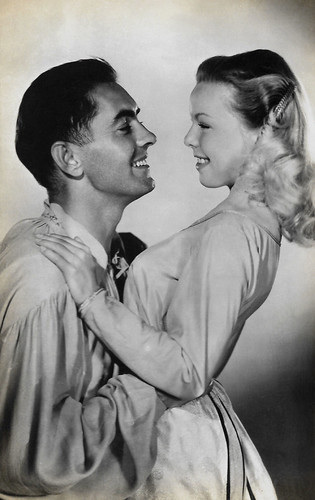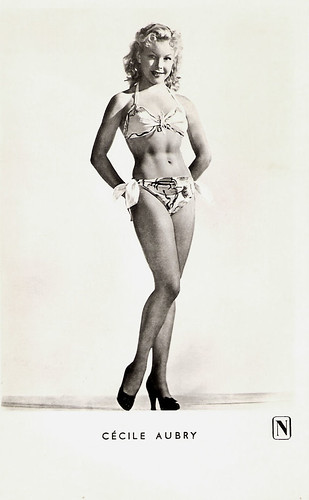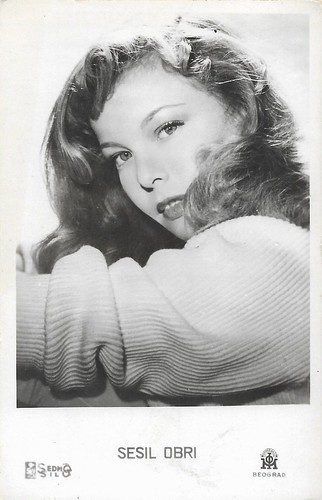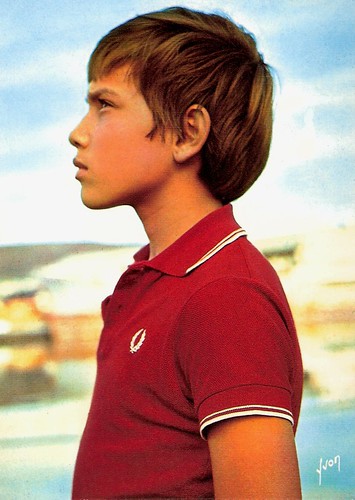
French postcard by Editions O.P, Paris, no. 55. Photo: Studio Harcourt.

French postcard by Editions O.P, Paris, no. 48. Photo: Teddy Piaz.

French postcard by Editions du Globe, Paris, no. 145. Photo: Sam Lévin.

Vintage card. Photo: 20th Century Fox. Cecile Aubry in The Black Rose (Henry Hathaway, 1950).

Italian postcard by Bromofoto, Milano, no. 265.
Seductive Pout
Cécile Aubry was born Anne-José Madeleine Henriette Bénard in Paris, France, in 1928. Her family was well-to-do, and Cécile had an English governess and a personal dance teacher. In her late teens, she studied acting at the Cours Simon, where she was discovered by famous film director Henri-Georges Clouzot.
Clouzot fell immediately for her ingenuity, her green bronze eyes, her blond hair and her seductive pout. He offered the 20-year-old Aubry the title role in Manon (Henri-Georges Clouzot, 1949), opposite Serge Reggiani and Michel Auclair. In this dark adaptation of Abbé Prévost's 18th-century novel Manon Lescaut, set in post-World War II, she played a capricious, luxury-seeking young woman who corrupts her lover.
Aubry managed to bring out the duality of the character – both femme fatale and femme enfant. She was a sensation. The film won the Golden Lion at the Venice Film Festival in 1949 and the 20-years-old Cécile landed on the cover of Life. In the accompanying article, the magazine described her as a “frisky, pert, sugar-and-spice bundle of adolescence.”
Ronald Bergan described in The Guardian what happened next: "in a blaze of typical Hollywood publicity, Cécile Aubry was signed up by 20th Century-Fox to co-star with Tyrone Power and Orson Welles in Henry Hathaway's The Black Rose. It was to be Aubry's only American film, placing her among several French actresses who had short-lived Hollywood careers after the liberation of France in 1944."
In her next, European film, Barbe-bleu/Bluebeard (Christian Jacque, 1951) she appeared as the last wife of Bluebeard, played in the French version by Pierre Brasseur and in the German version by Hans Albers. She performed a silhouetted striptease that left little to the imagination.
In the following years, she only appeared in a few more films, including Piovuto dal cielo/Fallen From the Sky (Leonardo De Mitri, 1953) and Tanz in der Sonne/Dance in the Sun (Géza von Cziffra, 1954) with Franco Andrei. None of these films were successful.

German postcard by Kolibri-Verlag. Photo: 20th Century Fox. Still from The Black Rose (1950) with Tyrone Power.

Spanish postcard by Sobe, no. 652. Tyrone Power and Cecile Aubry in The Black Rose (Henry Hathaway, 1950).

Dutch postcard by Uitg. Takken, Utrecht, no. 377. Photo: 20th Century Fox.

Belgian postcard. Photo: 20th Century Fox.

German postcard by Kunst und Bild, Berlin. Photo: publicity still for Barbe-Bleue/Bluebeard (Christian-Jaque, 1951).

German postcard by Kunst und Bild, Berlin, no. A 410. Photo: publicity still for Barbe-Bleue/Bluebeard (Christian-Jaque, 1951).

German postcard by Kunst und Bild, Berlin.
Secret marriage
Cécile Aubry stopped acting after her marriage to Si Brahim El Glaoui, caïd (local administrator) of Telouet and the oldest son of T'hami El Glaoui, pasha of Marrakech. During the filming of The Black Rose in the dunes of the Moroccan Atlas mountains, the couple had met when he visited the set. In 1955, they married in secret because Aubry thought that a marriage would harm her Hollywood career. In 1956, she announced her retirement from the cinema and reportedly said that she had only enjoyed film acting for its travel opportunities.
Their marriage lasted till 1959. After the divorce, she moved back to France. Aubry started a second successful career as a writer of children’s books. Her son Mehdi El Glaoui (only credited as Mehdi) later played roles in the French long-running TV series Poly (1961-1973) about a boy and his Shetland pony, and in the three series around Sébastien (1965-1970). These series were all written and directed by Aubry.
The most popular of these series was Belle et Sébastien/Belle and Sebastian (Cécile Aubry, 1965), which tells the adventures of a young orphan boy, Sébastien, in a small village in the Pyrenees, and the white Pyrenean Mountain Dog, Belle, whom he finds wandering through the mountains. Aubrey's series was broadcasted all over Europe during the 1960s. Later she also wrote and directed the series Le jeune Fabre/The Young Fabre (1973), again with Mehdi in the lead, now as a teenager.
Belle et Sébastien was adapted in 1981 for a Japanese animated series, Meiken Jolie, which was itself translated into English. The Scottish rock band Belle and Sebastian took its name from Aubry’s series too. Cécile Aubry last lived in a restored historic mill in the countryside, in Dourdan, near Paris. In 2010, she died of lung cancer, two weeks before her 82nd birthday.
In 2013, Belle et Sébastien was filmed again, but now for the cinema. In Belle et Sébastien/Belle and Sebastian (Nicolas Vanier, 2013), the six-year-old boy and his dog look to foil a Nazi effort to capture French Resistance fighters. Sébastien was played by Félix Bossuet and Mehdi El Glaoui played a supporting part. This film came only after Aubry's death, as she had consistently opposed it. There were a sequel, Belle et Sébastien, l'aventure continue (Christian Duguay, 2015) and the animation series Belle et Sébastien/Belle and Sebastian (Jean-Philippe Robin, 2017). A new film version, Belle et Sébastien: Nouvelle génération/ Belle and Sebastian - A new generation (Pierre Coré, 2022), followed this year.

Dutch postcard. Photo: 20th Century Fox.

Yugoslavian postcard by Sedma Sila. Photo: Morava Film, Beograd (Belgrade).

French postcard by Editions P.I., Paris, no. 179. Photo: Sam Lévin.

West-German postcard by Ufa, Berlin-Tempelhof, no. FK 629. Photo: Serge Beauvarlet, Paris.

West-German postcard by Ufa/Film-Foto, Berlin-Tempelhof, no. FK-1014. Photo: Sam Lévin, Paris.

West-German postcard by Ufa, Berlin-Tempelhof, no. FK 1145. Photo: Michaelis / Arion Film / Deutsche London Film. Cécile Aubry and Franco Andrei in Tanz in der Sonne/Dance in the Sun (Géza von Cziffra, 1954).

West-German postcard, offered by Cinema Capitole, Luxembourg. Franco Andrei and Cécile Aubry in Tanz in der Sonne/Dance in the Sun (Géza von Cziffra, 1954).

Mexican Collectors card, no. 302.

French postcard by Editions d'art Yvon, Paris, no. 6. Photo: RTF / Gaumont. Mehdi El Glaoui as Sebastien in the film and TV series Sébastien parmi les hommes (Cécile Aubry, 1968).

French postcard by Editions d'art Yvon, Paris. Photo: RTF, Gaumont Télévision International and Téléclip. Mehdi El Glaoui as Sebastien in the film and TV series Sebastien et la Mary-Morgane (Cécile Aubry, 1970).

French postcard by Editions d'art Yvon, Paris, no. 40/001-19. Photo: RTF / Gaumont / Téléclip. Mehdi El Glaoui in Sebastien et la Mary-Morgane (Cécile Aubry, 1970).
Sources: Marlene Pilaete (L'encinémathèque - now defunct), Ronald Bergan (The Guardian), Bruce Weber (The New York Times), Thomas Staedeli (Cyranos), Sandra Brennan (AllMovie), Wikipedia, and IMDb.
1 comment:
I have always wanted to see Black Rose for Orson Welles' role, now I have another reason
Post a Comment